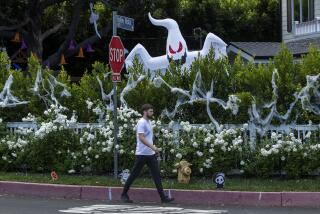Oh, What a Tangled Web We Weave . . .
- Share via
My modest essay on the spider and the bee seems to have divided my readers between those who approve my allowing the bee to be devoured by the spider, and those who despise me for it.
My wife had handed me a swatter to swat a bee that was buzzing in the kitchen window; before striking, though, I saw that the bee was caught in a web, and the spider was making swift little runs down the web to torment it.
My dilemma was exquisitely complex. I felt an impulse to rescue the bee. But my original intent had been to swat it. Why save it now, just because it was about to be killed and eaten? Besides, I doubted that I could extricate the bee from the web without fatally damaging its wings. Besides, I had read that a bee isolated from its colony was doomed. Besides, who was I to interfere in the working out of this commonplace natural event, an event that surely must have been contemplated in God’s scheme? Else why did he give spiders the ability to spin webs and sting their victims?
Referring to the metaphor of white hats and black hats to distinguish between the heroes and the villains in cowboy movies, Bob Baskin of Buena Park deplores what he calls my transformation from white hat to black.
“I have always pictured you as wearing a white hat bravely riding into the battle each day to save our language . . . and to champion innumerable other causes. Today I was stunned, shocked and also aghast when you arrived replete in a black outfit, wearing a black Stetson. Please tell me that it wasn’t the real Jack Smith that wrote today’s column.”
William Robb, an agricultural biologist in the Santa Barbara County Agricultural Commissioners’ Office, was ruthless:
“I found your story about the spider and the bee simply revolting,” he said. “Would you turn your back on, say, a young fawn, stuck in quicksand, if you were nearby with a rope?”
That hypothesis raises some practical as well as moral questions. Certainly I would want to save the fawn. To do so, though, I would have to make a noose in the rope, cowboy style, rope the fawn by the neck, and pull it out of the quicksand. I doubt that I have the skill to make and throw a lasso and the strength to pull a struggling fawn from quicksand. Also, I might be drawn into the quicksand myself. Would I risk my life to save a fawn? I can only hope that I am never placed in that dilemma.
“Bees are not sinister,” Robb goes on. “They do not sneak around waiting to pounce on their helpless prey. On the contrary, they help us immensely, and we in turn exploit them to the max. . . . They sting out of self-defense, which in turn is fatal to them.”
Robb says his first job out of college was as an apiary inspector in Fresno County. His boss, Bernard, would sing to the bees before opening their hives. “Once while being stung, I cursed at the offending bee. . . . I was reprimanded and told ‘You never swear at the bees. It upsets them.’ To this day, whenever I see a bee in distress, I try to help. . . . “
Gerald P. Lunderville praised my essay, observing that it might have helped him at home. “I promptly read it to my mother and will do the same when my wife comes home from work. Both these women won’t stay under the same roof if they know a spider is present. I refuse to kill a spider because I agree with you that these arachnids keep other unwanted pests away.”
Other readers explored the moral and philosophical aspects of the story. John Degatina says I was wise not to watch the spider devour the bee. “It’s as unpleasant as watching a human devour a chicken. That is, unless it’s been made into fajitas or coq au vin. “
Patty Privette observes that God works in mysterious ways. “Once I worked tediously to extricate a fly from a newly painted window sill, only to swat it when freed.”
Willard Olney of Hesperia asks, “If eating and being eaten are the two faces of the coin of life, what did the very first living thing eat?”
Easy. The first living thing ate the second living thing. Or vice versa.


